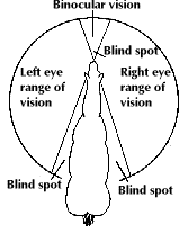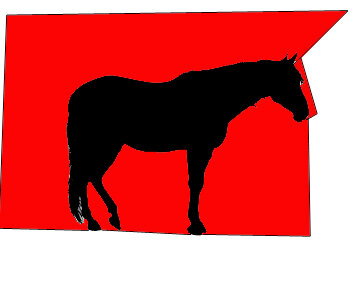
Are You Blind?
This is another one of those things that needs to be as important to us as it is to the horses (VERY, in other words!). Blind spots. Blind spots are very important to horses and they have a lot of them, actually. Blind spots are places where the horse literally cannot see what’s around him. In a prey animal, one can imagine, this could cause some pretty serious issues.
If a horse is troubled in one or more of his blind spots, it can cause things like bucking, bolting, spooking, striking and rearing (probably over 50% of these behaviors are caused by blind spot issues), all the way down to things like trouble picking up feet, problems mounting, trouble standing still, generalized anxiety, kicking horses who come up behind in group situations and high-headed “upside down” postures. Blind spot troubles can be subtle, and they can be huge. But it’s our job to recognize them and help the horse become okay with all the things that might happen with his blind spots. This is a large part of putting a foundation on a horse, dealing with all these blind spots. If this foundation piece is missing, shoddy or incomplete, the horse might exhibit some of the things mentioned above and more.
A horse has blind spots because, simply put, his eyes are placed on the sides of his head. A friend of mine and good horseman once suggested that we take our hand and make a fist and then put that fist between our eyes, touching our foreheads, to get a feel for how a horse’s eyes are separated. It’s weird! I found lots of diagrams of equine blind spots in a Google search, and they show the blind spots pretty clearly. I’ve shared one of those below. But what they don’t show is that the blind spots on a horse are three-dimensional. So I’ve added a drawing I doctored to help show another plane of the blind spots. The first diagram shows a map of blind spots on the horizontal plane, and the second shows a map on the vertical plane (I made that one myself, so be kind! I don’t know if it’s scientifically accurate, but I could not find a drawing of the vertical plane). You’ll kind of have to make a three-dimensional picture of your horse’s blind spots for yourself. Basically, if, from where you are positioned, you cannot see one or both of the horse’s eyes, he cannot see you. Also keep in mind that a horse has to move his head to change his field of vision, so anytime we fix his head in a position, we are also fixing his visual field and defining his blind spots for him.


So what about this? Well, we need to TEACH a horse to handle things in his blind spots. They don’t come “from the factory” with the blind spots taken care of. We have to remember that things can “pop” into a horse’s vision out of a blind spot and startle him. We need to remember that our toes are in his blind spots much of the time. We must keep in mind that the area behind his head (where we sit, for instance) is actually a blind spot until he turns his head. I’ve seen lots of riding horses that were actually NOT okay with things in the blind spot behind their head. Under his chin and in front of his chest are blind spots. If we reach in and slap, tap, push or otherwise “cue” a horse on his chest, that’s in a blind spot. Under his belly is a blind spot. Behind him is a blind spot. If a horse is in cross ties, he may not be able to turn his head enough to mitigate that blind spot that’s behind him, and he might become worried that something might happen back there that he can’t see. Some trail horses would rather have a horse behind them in their blind spot than be the last horse in line (first to be picked off by the predator?) and have that blind spot wide open to the world.
Then there’s the thing we call, “switching eyes”. Because the horse’s eyes are on the sides of his head, when something crosses from one field of vision, through a blind spot, to the other field of vision, the horse has to “switch eyes”. Say I’m grooming him and I walk around behind him. I just required him to “switch eyes”. I went, say, from his left eye, through his blind spot, to his right eye. Many, many horses have trouble switching eyes and this can cause profound training and behavioral problems. Some horses will work hard to keep things on one side or the other (their more comfortable side, of course). We need to know when we’re asking a horse to switch eyes (because HE knows we’re asking him to switch eyes) and be able to observe how he feels about it. If he is not confident and okay with it, then we need to help him with that. That is our responsibility.
There are lots of ways to help a horse with blind spot skills and issues. Different styles of training do it different ways, so the information is out there, in many forms. If you feel like your horse may have issues with his blind spots, and you don’t feel qualified to deal with those, then you can find a trainer who can help you both. If you have a horse in training, you may want to ask the trainer what has been done about the horse’s blind spots, so you’re an educated consumer.
The take-aways here are two-fold. Firstly, if we have a horse, ride horses or handle horses, we need to know what the blind spots are and where they are. Then it would be great if we were able to self-diagnose if our horse has an issue/behavioral/training problem that might be coming from a blind spot issue. A horse with a blind spot issue is not being a “butt-head” or “spooky” or “high energy”, he’s genuinely worried.
Secondly, I’d like us to understand how blind spots raise the level of difficulty of any skill or task for a horse. For instance, if we’re getting a horse used to a stick, flag or rope, we need to keep it out of the blind spots at first. We need to work in the areas where the horse CAN see, then GRADUATE to the blind spots. It’s easy to blow a horse up if we go after those blind spots first, and that horse may never get over that. Recognize that things happening in blind spots raise the level of difficulty of any common task. For instance, leading a baby horse in from the pasture is one thing, but leading him in while things (dogs, horses, traffic, whatever) are moving around behind him, in and out of his blind spot raises the level of difficulty exponentially. When we’re riding a colt, for instance, giving cues on both sides of his body raises the level of difficulty exponentially, while giving cues that are all on one side is simpler. That kind of keeps things “in one eye”, so to speak. We also need to know if our horse takes over deciding which eye to work on. We need to know which eye he offers easiest and then we need to be able to focus on getting both eyes “equal” (symmetrical). A lot of the “asymmetry” or one-sidedness horse people talk about is actually about switching eyes and the eyes being symmetrical, or not. We need to understand how this concept influences the progressive nature of increasing the level of difficulty for our horses.
A few years ago, we had a horse in here at our place for training that was having trouble cantering under saddle. He just didn’t want to do it, despite all the encouraging techniques the owner had tried over time. So we went back to the beginning with this horse and found some interesting things. The horse had a lot of things that were working fine, and overall, the horse was very functional. But the horse had trouble backing off a trailer. He had trouble with his back feet with the farrier. He would pull back if tied and something moved behind him. If you were in the round pen and you turned him to the outside, so you passed through his blind spot, he’d scoot through as fast as he could. So we spent a lot of time getting that horse feeling really good about switching eyes behind him, and getting him comfortable with things happening in his rear blind spot.
Once we did all that work, we got on the horse in the round pen, and about the first thing he offered to do was to canter. I wouldn’t have believed it if I hadn’t experienced it for myself. That horse went on to be willing to canter as we moved him around different areas of the farm. It was one of the coolest changes I’d ever seen in a horse.
It’s not always easy to see HOW things are connected in a horse. It’s not always linear, and it’s not always very logical from a human perspective. Blind spot issues, in particular, seem to manifest sometimes in pretty bizarre ways, so it’s one of those things that needs to go on the “applies to ALL horses” list, regardless of the horse’s age, breed, the discipline he works in, the style of his saddle or even his color. In this way, “a horse is a horse is a horse”.
Want more discussion on these types of subjects? Join the Ethos Equine Subscription Community here!!!!